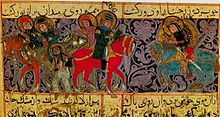Ayyuqi | |
|---|---|
| Occupation | Poet |
| Language | Persian |
| Genre | Poetry |

Ayyuqi ( Persian: عیوقی) was an 11th-century Persian poet. A contemporary of the Ghaznavid ruler Mahmud of Ghazni ( r. 998–1030) he wrote the epic Varqa wa Golshāh (ورقه و گلشاه) in 2,250 verses, which is a story of the love between a youth named Varqa and a maiden, Golshah. [1] In the introduction, he eulogizes Mahmud of Ghazni. [1] According to the poet himself, the story is based on the Arabic work ‘Orwa wa ‘Afra. The work survives in a unique manuscript dated to the mid-13th century and made in Konya ( Seljuk Rum), which is now located in the Topkapi Museum (Topkapı Sarayı Müzesi, Hazine 841 H.841). [2]. Ayyuqi also wrote some qasidas. No reliable information about Ayyuqi has come down. [1] His works are characterized by paired rhyme interspersed with ghazal.
See also
References
- ^ a b c Khaleghi-Motlagh, Dj. (1987). "ʿAyyūqī". In Yarshater, Ehsan (ed.). Encyclopædia Iranica, Volume III/2: Awāʾel al-maqālāt–Azerbaijan IV. London and New York: Routledge & Kegan Paul. pp. 167–168. ISBN 978-0-71009-114-7. Retrieved February 26, 2012.
- ^ Ettinghausen, Richard (1977). Arab Painting. New York: Rizzoli. pp. 91–92. ISBN 978-0-8478-0081-0.
General references
- Rypka, Jan (1968). History of Iranian Literature. Reidel Publishing Company. ISBN 90-277-0143-1. OCLC 460598.
- Ahmad, Ateş (1954). "Yak mathnavī-i gum-shuda az dawra-yi Ghaznaviyān, Varqa va Gulshāh-i ʿAyyūqī". Majalla-yi Dānishkada-yi adabiyāt-i Dānishgāh-i Tihrān. 1 (4): 1–13.
Ayyuqi | |
|---|---|
| Occupation | Poet |
| Language | Persian |
| Genre | Poetry |

Ayyuqi ( Persian: عیوقی) was an 11th-century Persian poet. A contemporary of the Ghaznavid ruler Mahmud of Ghazni ( r. 998–1030) he wrote the epic Varqa wa Golshāh (ورقه و گلشاه) in 2,250 verses, which is a story of the love between a youth named Varqa and a maiden, Golshah. [1] In the introduction, he eulogizes Mahmud of Ghazni. [1] According to the poet himself, the story is based on the Arabic work ‘Orwa wa ‘Afra. The work survives in a unique manuscript dated to the mid-13th century and made in Konya ( Seljuk Rum), which is now located in the Topkapi Museum (Topkapı Sarayı Müzesi, Hazine 841 H.841). [2]. Ayyuqi also wrote some qasidas. No reliable information about Ayyuqi has come down. [1] His works are characterized by paired rhyme interspersed with ghazal.
See also
References
- ^ a b c Khaleghi-Motlagh, Dj. (1987). "ʿAyyūqī". In Yarshater, Ehsan (ed.). Encyclopædia Iranica, Volume III/2: Awāʾel al-maqālāt–Azerbaijan IV. London and New York: Routledge & Kegan Paul. pp. 167–168. ISBN 978-0-71009-114-7. Retrieved February 26, 2012.
- ^ Ettinghausen, Richard (1977). Arab Painting. New York: Rizzoli. pp. 91–92. ISBN 978-0-8478-0081-0.
General references
- Rypka, Jan (1968). History of Iranian Literature. Reidel Publishing Company. ISBN 90-277-0143-1. OCLC 460598.
- Ahmad, Ateş (1954). "Yak mathnavī-i gum-shuda az dawra-yi Ghaznaviyān, Varqa va Gulshāh-i ʿAyyūqī". Majalla-yi Dānishkada-yi adabiyāt-i Dānishgāh-i Tihrān. 1 (4): 1–13.